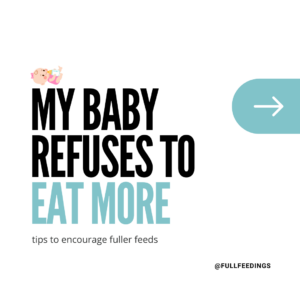My Baby Refuses to Eat More
 Whether your baby is a newborn or just going through a phase, if they are struggling to finish a full feeding it can be really frustrating.
Whether your baby is a newborn or just going through a phase, if they are struggling to finish a full feeding it can be really frustrating.
We know that full feedings are an important ingredient in establishing and maintaining your consistent nighttime sleep, so we wanted to provide some things to try if you are in the sleepy newborn phase or are suddenly dealing with a distracted baby who is not wanting to finish their full feedings.
Here are some tips for when your baby refuses to eat more:
Actively work to encourage them to eat fully (without forcing them).
Feeding is not passive. This doesn’t mean we force feed a baby, we never do that. But, we do want to work to encourage them to eat fully by stopping to burp often and taking breaks when needed.
Warm the bottle.
Babies like warm milk. Breastmilk is naturally warm and many (if not most) babies prefer the milk to be warm. When babies have trouble eating fully, we always want to make sure we’re warming the milk to a comfortable temperature.
Use an age-appropriate nipple.
No one tells you this, but it’s important to increase the nipple size as they get older. It can vary for each bottle, so make sure to look up the sizes for the bottle you’re using. If the flow is too slow, your baby may not be interested in eating more, because they’re working too hard to get the milk. We believe in increasing nipple sizes even if you’re also breastfeeding. We feel that if you have a good breastfeeding relationship, this won’t lead to nipple confusion. We typically recommend sizing up a nipple level 1-month before the manufacturer’s recommendation. If you are having to size up sooner than that, we typically recommend looking into a different bottle system.
Take short breaks.
It’s important to take short breaks when you’re feeding, especially as your baby gets older. As they get older, they can get distracted eating more easily. In order to keep them engaged in eating, we stop and take short breaks to bring them back to and focused on the task at hand. When taking a break you can stop to look out the window, sing a little song, make silly faces, etc.
Keep the feed within 30-minutes.
We don’t want to feed for longer than 30 minutes because the energy it takes them to consume more is burning off any of the calories they may be consuming, so it’s really like negative calories. Also, it takes a lot of energy for them to feed, so sometimes feeding longer than 30-minutes can also lead to over tiredness, which can compromise their sleep…and we don’t want that.
Head to a quiet environment to feed.
Babies can be very distracted eaters. When this happens, we want to feed in a quiet environment. For many, this means feeding in their bedroom with the lights off. The goal is to limit other stimuli so that they can focus all of their attention on eating fully.
Burp well.
Oftentimes trapped gas can make a baby feel full, so make sure you are stopping frequently to burp. When you have a newborn, we recommend feeding for 5 minutes, burping for up to 5 minutes, and repeating the process until you get to 30 minutes. If your baby is older, you still want to stop to burp several times during their feed to ensure trapped gas isn't preventing them from taking the full feeding they need to remain full and satiated and SLEEPING!!!
We also recommend offering EAT PLAY EAT SLEEP in some cycles to help increase daytime intake when needed, which can be especially helpful for nursing parents.
If you are a member and experiencing trouble with full feeds, reach out to infant@fullfeedings.com for email support.
If you are not yet a member, check out our NO CRY IT OUT sleep method here!
We have super affordable infant & toddler online programs that will teach you an easy 3-step method to get your little one to sleep through the night.
We also offer courses on Breastfeeding and Bottle Feeding to help you establish and maintain those full feedings.


